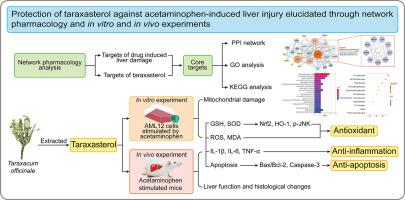Phytomedicine ( IF 6.7 ) Pub Date : 2023-05-13 , DOI: 10.1016/j.phymed.2023.154872 Bingjie Ge 1 , Rui Sang 2 , Wei Wang 2 , Kexin Yan 1 , Yifan Yu 2 , Lin Kong 2 , Minghong Yu 2 , Xinman Liu 2 , Xuemei Zhang 2

|
Background
: Drug-induced liver injury (DILI) is primarily caused by drugs or their metabolites. Acetaminophen (APAP) is an over-the-counter antipyretic analgesic that exhibits high hepatotoxicity when used for long-term or in overdoses. Taraxasterol is a five-ring triterpenoid compound extracted from traditional Chinese medicinal herb Taraxacum officinale. Our previous studies have demonstrated that taraxasterol exerts protective effects on alcoholic and immune liver injuries. However, the effect of taraxasterol on DILI remains unclear.
Hypothesis/Purpose
: This study aimed to elucidate the effects and mechanisms of action of taraxasterol on APAP-induced liver injury using network pharmacology and in vitro and in vivo experiments.
Methods
: Online databases of drug and disease targets were used to screen the targets of taraxasterol and DILI, and a protein-protein interaction network (PPI) was constructed. Core target genes were identified using the tool of Analyze of Cytoscape, gene ontology (GO) and Kyoto Encyclopaedia of Genes and Genomes (KEGG) enrichment analyses were performed. Oxidation, inflammation and apoptosis were evaluated to determine the effect of taraxasterol on APAP-stimulated liver damage in AML12 cells and mice. Reverse transcription-quantitative polymerase chain reaction (RT-qPCR) and western blotting were used to explore the potential mechanisms of taraxasterol against DILI.
Results
: Twenty-four intersection targets for taraxasterol and DILI were identified. Among them, 9 core targets were identified. GO and KEGG analysis showed that core targets are closely related to oxidative stress, apoptosis, and inflammatory response. The in vitro findings showed that taraxasterol alleviated mitochondrial damage in AML12 cells treated with APAP. The in vivo results revealed that taraxasterol alleviated pathological changes in the livers of mice treated with APAP and inhibited the activity of serum transaminases. Taraxasterol increased the activity of antioxidants, inhibited the production of peroxides, and reduced inflammatory response and apoptosis in vitro and in vivo. Taraxasterol promoted Nrf2 and HO-1 expression, suppressed JNK phosphorylation, and decreased the Bax/Bcl-2 ratio and caspase-3 expression in AML12 cells and mice.
Conclusion
: By integrating network pharmacology with in vitro and in vivo experiments, this study indicated that taraxasterol inhibits APAP-stimulated oxidative stress, inflammatory response and apoptosis in AML12 cells and mice by regulating the Nrf2/HO-1 pathway, JNK phosphorylation, and apoptosis-related protein expression. This study provides a new evidence for the use of taraxasterol as a hepatoprotective drug.
中文翻译:

通过网络药理学和体内外实验阐明蒲公英甾醇对对乙酰氨基酚诱导的肝损伤的保护作用
背景
: 药物性肝损伤 (DILI) 主要由药物或其代谢物引起。对乙酰氨基酚 (APAP) 是一种非处方解热镇痛药,长期或过量使用时会表现出高肝毒性。蒲公英甾醇是一种从中药蒲公英中提取的五环三萜类化合物。我们之前的研究表明,蒲公英甾醇对酒精性和免疫性肝损伤具有保护作用。然而,蒲公英甾醇对 DILI 的影响仍不清楚。
假设/目的
: 本研究旨在通过网络药理学和体内外实验阐明蒲公英甾醇对 APAP 诱导的肝损伤的影响和作用机制。
方法
: 利用药物和疾病靶点的在线数据库筛选蒲公英甾醇和DILI的靶点,并构建了蛋白质-蛋白质相互作用网络(PPI)。使用 Analyze of Cytoscape 工具鉴定核心靶基因,进行基因本体论 (GO) 和京都基因与基因组百科全书 (KEGG) 富集分析。评估氧化、炎症和细胞凋亡以确定蒲公英甾醇对 AML12 细胞和小鼠中 APAP 刺激的肝损伤的影响。逆转录定量聚合酶链反应 (RT-qPCR) 和蛋白质印迹被用来探索蒲公英甾醇抗 DILI 的潜在机制。
结果
:确定了二十四个蒲公英甾醇和 DILI 的交叉目标。其中,确定了9个核心目标。GO和KEGG分析表明,核心靶点与氧化应激、细胞凋亡和炎症反应密切相关。体外研究结果表明,蒲公英甾醇减轻了用 APAP 处理的 AML12 细胞的线粒体损伤。体内实验结果表明,蒲公英甾醇可减轻 APAP 处理小鼠肝脏的病理变化,并抑制血清转氨酶的活性。蒲公英甾醇在体外和体内增加抗氧化剂活性,抑制过氧化物的产生,降低炎症反应和细胞凋亡. 蒲公英甾醇促进 Nrf2 和 HO-1 表达,抑制 JNK 磷酸化,并降低 AML12 细胞和小鼠中的 Bax/Bcl-2 比率和 caspase-3 表达。
结论
:通过将网络药理学与体外和体内实验相结合,这项研究表明蒲公英甾醇通过调节 Nrf2/HO-1 通路、JNK 磷酸化和细胞凋亡来抑制 AML12 细胞和小鼠中 APAP 刺激的氧化应激、炎症反应和细胞凋亡-相关蛋白表达。该研究为蒲公英甾醇作为保肝药物的应用提供了新的证据。











































 京公网安备 11010802027423号
京公网安备 11010802027423号